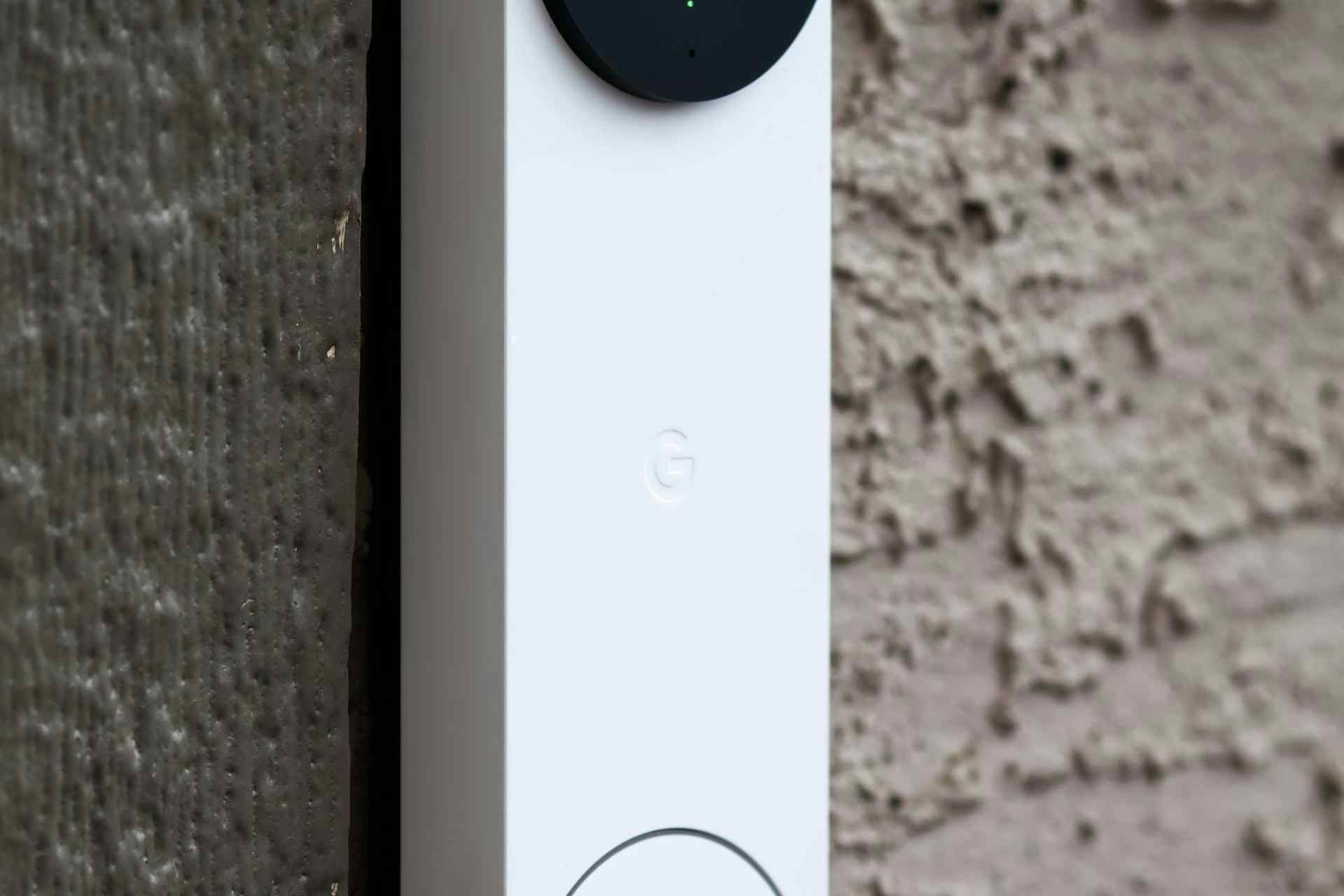Wireless doorbells are not an especially new invention, but they've become modernised via features like motion sensors, intercoms and video.
The latest generation of wireless doorbells are smart home-compatible, and you can link them with smartphones and smart home devices.
This lets you see who is at the door using a video feed on your smartphone. You can talk to visitors from anywhere with an internet connection!
What is a wireless doorbell?
Today, most doorbells are probably wireless. The technology is simple; wireless doorbells feature a transmitter inside the doorbell, and a receiver, placed somewhere in your home. Once the doorbell is depressed, the transmitter sends a radio signal to the receiver, which activates the door chime.
Wireless doorbell setups are cordless - you don’t need to worry about running cables from your outside doorbell inside your home. Also, you’ll likely have a choice of fully adjustable volume chime sounds.
Some wireless doorbells support multiple receivers, ensuring you'll hear the door whether you're upstairs, downstairs, inside, or out in the garden.
How do wireless doorbells work?
Wireless doorbells work by transmitting a wireless radio signal from the transmitter in the doorbell to the receiver, which is inside. Wireless doorbells negate the need for any cabling.
While many wireless doorbell systems have just one doorbell and receiver, you can have more than one. For example, many doorbell kits on Amazon come with several receivers you can place around your house and garden.
The benefits of wireless doorbells
Standard wireless doorbells are widely available today. They outperform wired doorbells in practically every way. Here are their primary characteristics and benefits.
Easy to install
You can install wireless doorbells on practically any door or doorframe.
There's no cabling, so you can stick the doorbell to the wall or door and place the receiver inside. Most models come with fixings you attach to the wall, allowing you to detach the doorbell unit to charge the batteries easily.
You're good to go once the doorbell and receiver are paired (which will probably be automatic).
The wireless range of most modern wireless doorbells is over 20m or so, so you can place the receiver unit pretty much anywhere in your home.
Customisation
Setting and adjusting volume and selecting different chimes should be straightforward if you have a newer wireless doorbell. You can usually change chime and volume settings from the receiver unit.
Some wireless doorbells like this 3-receiver package allow users to choose from 58 different chimes!
Affordable
Wireless doorbell kits are affordable. For example, you can buy a customisable waterproof wireless doorbell kit for less than £15.
The best wireless doorbells
There are loads of wireless doorbells on the market, and most are pretty reliable. Here are four of the best wireless doorbells:
Honeywell DC515NBS
The Honeywell Home series of doorbells provides excellent value for anyone who wants a loud, reliable wireless doorbell.
This model features up to 150m wireless range and a digitally enhanced chime with a maximum volume of 84dB. It's straightforward to install and includes a battery for the push button.
Byron DBY-22314UK
This dual-receiver wireless doorbell kit from trusted brand Byron also features a whopping 150m wireless range. There are two receivers; you can install one upstairs and one downstairs, or whatever else you choose. In addition, you can select from 16 loud chimes at five different volume levels.
TECKNET Wireless Doorbell
This cheap wireless doorbell has a 400m maximum wireless range.
It's well-made with 38 different chimes at four adjustable volume levels ranging from 25db to 110db. An excellent doorbell at a great price.
TECKNET Self-Powered Doorbell
This twin pack setup is entirely battery-free; it can transmit its radio signal without battery power!
The receivers plug into the mains and don't occupy a mains socket, essentially acting as an extension of the socket—a superb wireless doorbell.
Smart doorbells
Wireless doorbells do the job, but a new generation of doorbells - smart doorbells - might be even more attractive.
But how can a doorbell be smart, you might ask?
Smart doorbells are part of the smart home ‘movement’. They link to smart home systems and smart speakers like Amazon Alexa, Google Home, and Apple Homekit.
Some smart doorbells use their own standalone smartphone app and don't require integration with a home assistant.
As well as functioning as a standard doorbell, smart doorbells pack in lots of helpful tech. While many people assume they're a bit gimmicky, you'll probably get more use out of a smart doorbell than most smart home gadgets. If you're looking for another device to pair with a smart doorbell, consider a smart door lock.
We spoke to Hollie Ferris from Keytek, who told Age Times: "Smart doorbells are a great home security addition as they offer a range of different features for which you can secure your home. As experts within the security industry they are one of the top products that we would suggest for homeowners to invest in.”
What is a smart doorbell?
Smart doorbells take wireless doorbells one step further. These are wireless doorbells that connect to your smartphone and smart home hub or display, if you have one. Smart doorbells typically consist of a camera, speaker, and microphone.
When someone rings the door, a two-way video and audio feed is sent to your phone or smart home display, if you have one. Smart doorbells typically use rechargeable batteries, but you can set some up with solar power.
Once set up, you can see who is at the door and speak to them through your phone as if your doorbell and intercom panel. Some more advanced models feature facial recognition. A smart doorbell design proposed by Amazon Ring may even be able to recognise people by their smell!
While these somewhat futuristic features are bound to divide people, simpler smart doorbells are reliable and provide several benefits over standard wireless doorbells.
In many ways, smart doorbells are compact intercom panels that fit a similar profile to a standard doorbell.
Smart doorbell features
Smart doorbell kits have loads of features, which can be overwhelming when choosing the right one for you.
Here's a list of standard smart doorbell features:
- Wireless: Most smart video doorbells are wireless, but wired versions are available. WiFi video doorbells are reliable so long as they're within a suitable range of your router. Some also use Bluetooth as a backup. Wired models are advantageous if you want the camera to record all the time, which would otherwise drain the battery.
- Video footage: The hallmark of the smart doorbell is a video feed. This lets you see who's at your door using your smartphone or smart display.
- Notifications: Smart doorbells will notify you when someone moves within range of your doorbell or presses the button.
- Audio: Smart doorbells should feature two-way audio as standard. This enables you to communicate with whoever is at your door via your phone or smart home device.
- Motion detection: Smart doorbells should detect when someone is at or near your door and notify you of their presence. Most smart doorbells use PIR motion sensors that detect people via the infrared light radiating from their bodies. Earlier models had trouble discerning humans from other movements, like animals and cars, but this is less of an issue now.
- Facial recognition: A newer feature on some smart doorbells, such as the Google Nest Doorbell. Facial recognition provides a person-specific alert when someone you know is at your door.
- Video recording: Some devices save video footage to the cloud so that you can review any footage later.
The benefits of smart doorbells
Smart doorbells fulfil all the same roles as a standard wireless doorbell. However, they come with several additional benefits:
Home security
Smart doorbells feature security cameras and two-way audio. The role of security devices in deterring crime is not a marketing ploy - it's proven. For example, a survey of some 400 convicted offenders found that 60% were deterred from burglary by the presence of security devices.
Most smart doorbells contain excellent HD cameras that operate at resolutions of 1080p and higher. They also feature high-quality night vision for capturing clear footage at night time. You can pair smart doorbells with other smart cameras such as Arlo, or outdoor lights, to build a very secure home without breaking the bank. In addition, smart home security systems are much cheaper and more accessible than CCTV.
In addition, smart video doorbells enable you to see anyone who scouted out your front door and provide valuable footage of parcel thieves.
Convenience
Have you ever been out, in bed, or in the garden, and the delivery person took your parcel to the local depot for collection? This is the kind of situation that a smart doorbell negates. Being able to see and speak to whoever at your door is tremendously convenient - it's much more than just a novelty.
Lowers home insurance
Smart doorbells may count as security devices on your homeowner’s insurance. In some cases, they’ll slash your home insurance bill.�
As of 2022, many insurers have announced they’re starting to consider innovative home security devices when calculating house insurance bills. Any security footage provided via a smart doorbell is bound to help when it comes to making claims.
How do you set up smart doorbells?
Smart doorbells are relatively straightforward to set up. Before you begin, you’ll need to choose a home assistant. It's possible to use some smart doorbells without a home assistant - you can sometimes control the doorbell from the device's app.
Smart homes link to a central hub controlled by a home assistant such as Amazon Alexa or Google Home. You can manage your smart home devices through this assistant or your smartphone.
Once you've chosen a home assistant, you'll need to select a doorbell. First, ensure your smart doorbell is compatible with your assistant.
For example, Amazon has their Alexa-specific doorbells called Ring, whereas Google has their Google-specific doorbells called Nest Doorbell. Remember, not all smart doorbells require you to own a smart home ecosystem.
Then, it’s just a matter of installing the doorbell itself and linking it to your smart home system.
Most smart doorbells work over WiFi, so you’ll need to make sure it’s within range of your WiFi router.
Some also use Bluetooth as a backup if the WiFi fails. In addition, smart doorbells are rechargeable with standard USB chargers.
The best wireless video doorbells
Let’s take a look at some of the best wireless video doorbells available:
Ring 2 Video Doorbell by Amazon
This is the 2nd gen Ring Doorbell by Amazon. Since then, two more Ring Doorbells have been released; the Ring 3 and Ring 4. There is also the Ring Pro range, which is hardwired, which we'll get onto in a second.
The Ring 2 works over WiFi, ideally with Alexa, and features 1080p video recording and two-way audio. It has a built-in rechargeable battery that's easy to remove and that you can link to a Ring Chime, which is essentially a traditional chiming receiver box. This plug-in door chime enables you to operate your smart doorbell as a regular plug-in wireless doorbell.
The Ring 2 covers the main features, with motion-sensing technology and decent night vision. The Ring doorbells come in a trademark ‘satin nickel’ colour and look pretty smart.
Ring Video Doorbell Pro
The Ring Video Doorbell Pro is hardwired. Why? Because it’s on all the time and provides a constant video feed.
Other video doorbells only activate when the motion sensor detects something is nearby. If this device had a battery, it would soon be dead. In essence, this doorbell acts as a CCTV camera and a doorbell.
You install the Ring Video Pro using a transformer that plugs into the mains. Otherwise, it works similarly to the other Ring models.
Ring Video Doorbell 3 by Amazon
The Ring 3 is very similar to the Ring 2, with the same camera and audio system. However, it offers superior motion-sensing technology and connectivity, which should boost its wireless range.
While it’s hardly worth upgrading from the Ring 2 to the Ring 3, the Ring 3 is better, albeit marginally.
Ring Video Doorbell 4 by Amazon
Again, the Ring 4 doesn’t offer much more than its predecessors. The main upgrade is the Pre-Roll feature. The Pre-Roll feature captures the first few seconds before the motion sensor kicks in.
This gives you a 'prelude' to the event your smart doorbell captures. It helps catch parcel thieves or people scouting out your home.
Ring Video Doorbell Pro 2
With a higher definition of 1536p and round-the-clock video capture, this is currently the highest-end Ring Doorbell available.
Like the Ring Pro, this model is hardwired to cater for the always-on video feed. It also offers exceptionally clear colour night vision.
Google Nest Doorbell
The Google Nest Doorbell system features two models, a wireless model and a wired model.
The wireless model is slightly lower spec, but both have the same resolution, 960p. The video quality is superb, even at night. In addition, Google's smart alerts system lets you see who went to the door using facial recognition technology.
The Google Nest Doorbell does everything the Amazon Ring does, suiting those who use Google Home.
Eufy Security, Video Doorbell 2K
Stepping outside of Google and Amazon, we find the Eufy Video Doorbell range.
This particular model features superior 2K resolution. It’s also excellent at discerning between humans and other movements, reducing false notifications. It also boasts up to half a year of operation on just one charge of the batteries.
You can set up this doorbell with either Alexa or Google Home for voice commands. You can also operate it using its own smartphone app, which provides most of the features you need. So, you can use this smart doorbell without Alexa, Google Home or Apple Homekit.
Video and audio streams and controls are operated via its own smartphone app. Overall, it's easy to set up and works well with most smart home ecosystems.
ieGeek Video Doorbell
Like the above, the budget ieGeek Video Doorbell uses its own app. So you can use it without Alexa or Google Home, for example. This is a solid, cost-effective 1080p doorbell which offers most of the standard features you expect, including two-way audio, motion sensing and notifications sent to your smartphone.
One charge of the batteries provides around 2 to 3-months of functionality. It can also be hardwired. This is a great video doorbell that works without a smart home ecosystem.
Summary: How do wireless doorbells work?
Wireless doorbells are handy bits of kit. They’re easy to install and work reliably.
While standard wireless doorbells are ubiquitous today, the smart doorbell represents a new frontier for doorbell technology. Smart doorbells link to video and audio feeds, allowing you to see and communicate with whoever's at the door.
While the concept will undoubtedly seem gimmicky to some, smart doorbells are beneficial when receiving deliveries, boost your home's security, and may even lower your home insurance.
Image Credit: James Yarema at Unsplash








